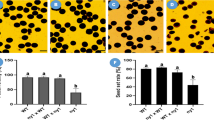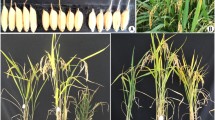Abstract
Autotetraploid rice has greater genetic variation and higher vigor than diploid rice, but low pollen fertility is one of the major reasons for low yield of autotetraploid rice. Very little is known about the molecular mechanisms of low pollen fertility of autotetraploid rice. In this study, cytological observations and microarray analysis were used to assess the genetic variation during pollen development in autotetraploid and diploid rice. Many abnormal chromosome behaviors, such as mutivalents, lagged chromosomes, asynchronous cell division, and so on, were found during meiosis in autotetraploid. Microsporogenesis and microgametogenesis in autotetraploid rice was similar to diploid rice, but many different kinds of abnormalities, including microspores degeneration, multi-aperture, and abnormal cell walls, were found in autotetraploid rice. Compared with diploid rice, a total of 1,251 genes were differentially expressed in autotetraploid rice in pollen transcriptome, among them 1,011 and 240 genes were up-regulated and down-regulated, respectively. 124 and 6 genes were co-up-regulated and co-down-regulated during three pollen development stages, respectively. These results suggest that polyploidy induced up-regulation for most of the genes during pollen development. Quantitative RT-PCR was done to validate 12 differentially expressed genes selected from functional categories based on the gene ontology analysis. These stably expressed genes not only related to the pollen development genes, but also involved in cell metabolism, cell physiology, binding, catalytic activity, molecular transducer activity, and transcription regulator activity. The present study suggests that differential expression of some key genes may lead to complex gene regulation and abnormal pollen development in autotetraploid rice.








Similar content being viewed by others

References
Allario T, Brumos J, Colmenero-Flores JM, Tadeo F, Froelicher Y, Talon M, Navarro L, Ollitrault P, Morillon R (2011) Large changes in anatomy and physiology between diploid Rangpur lime (Citrus limonia) and its autotetraploid are not associated with large changes in leaf gene expression. J Exp Bot 62:2507–2519
Aversano R, Caruso I, Aronne G, De Micco V, Scognamiglio N, Carputo D (2013) Stochastic changes affect Solanum wild species following autopolyploidization. J Exp Bot 64:625–635
Aya K, Suzuki G, Suwabe K, Hobo T, Takahashi H, Shiono K, Yano K, Tsutsumi N, Nakazono M, Nagamura Y, Matsuoka M, Watanabe M (2011) Comprehensive network analysis of anther-expressed genes in rice by the combination of 33 laser microdissection and 143 spatiotemporal microarrays. PLoS One 6(10):e26162
Boden SA, Langridge P, Spangenberg G, Able JA (2009) TaASY1 promotes homologous chromosome interactions and is affected by deletion of Ph1. Plant J 57:487–497
Borg M, Brownfield L, Twell D (2009) Male gametophyte development: a molecular perspective. J Exp Bot 60:1465–1478
Deng Z, Wang T (2007) OsDMC1 is required for homologous pairing in Oryza sativa. Plant Mol Biol 65:31–42
Deveshwar P, Bovill WD, Sharma R, Able JA, Kapoor S (2011) Analysis of anther transcriptomes to identify genes contributing to meiosis and male gametophyte development in rice. BMC Plant Biol 11:1–20
Doyle JJ, Flagel LE, Paterson AH, Rapp RA, Soltis DE, Soltis PS, Wendel JF (2008) Evolutionary genetics of genome merger and doubling in plants. Annu Rev Genet 42:443–461
Du Z, Zhou X, Ling Y, Zhang ZH, Su Z (2010) AgriGO: a GO analysis toolkit for the agricultural community. Nucl Acids Res 38:64–70
Feng JH, Lu YG, Liu XD, Xu XB (2001) Pollen development and its stages in rice (Oryza sativa L.). Chin J Rice Sci 15:21–28
Goldberg RB, Beals TP, Sanders PM (1993) Anther development: basic principles and practical applications. Plant Cell 5:1217–1229
Han LZ, Wei XH (2006) Descriptors and data standard for rice (Oryza sativa L.). China Agricultural Press, Beijing
He JH, Shahid MQ, Chen ZX, Chen XA, Liu XD, Lu YG (2011a) Abnormal PMC microtubule distribution pattern and chromosome behavior resulted in low pollen fertility of an intersubspecific autotetraploid rice hybrid. Plant Syst Evol 291:257–265
He JH, Shahid MQ, Li YJ, Guo HB, Cheng XA, Liu XD, Lu YG (2011b) Allelic interaction of F1 pollen sterility loci and abnormal chromosome behavior caused pollen sterility in intersubspecific autotetraploid rice hybrids. J Exp Bot 62:4433–4445
Hollister JD, Arnold BJ, Svedin E, Xue KS, Dilkes BP, Bomblies K (2012) Genetic adaptation associated with genome-doubling in autotetraploid Arabidopsis arenosa. PLoS Genet 8:1–10
Li H, Yuan Z, Vizcay-Barrena G, Yang CY, Liang WQ, Zong J, Wilson ZA, Zhang DB (2011) Persistent tapetal cell 1 encodes a PHD-finger protein that is required for tapetal cell death and pollen development in rice. Plant Physiol 156:615–630
Li XD, Yu ER, Fan CC, Zhang CY, Fu TD, Zhou YM (2012) Developmental, cytological and transcriptional analysis of autotetraploid Arabidopsis. Planta 236:579–596
Luan L, Wang X, Long WB, Liu YH, Tu SB, Zhao ZP, Kong FL, Yu MQ (2008) Microsatellite analysis of genetic variation and population genetic differentiation in autotetraploid and diploid rice. Biochem Genet 46:248–266
Ma H (2005) Molecular genetic analyses of microsporogenesis and microgametogenesis in flowering plants. Annu Rev Plant Biol 56:393–434
Masterson J (1994) Stomatal size in fossil plants: evidence for polyploidy in majority of angiosperms. Science 264:421–424
Nonomura K, Nakano M, Eiguchi M, Suzuki T, Kurata N (2006) PAIR2 is essential for homologous chromosome synapsis in rice meiosis I. J Cell Sci 119:217–225
Riddle NC, Jiang HM, An LL, Doerge RW, Birchler JA (2010) Gene expression analysis at the intersection of ploidy and hybridity in maize. Theor Appl Genet 120:341–353
Sanders PM, Bui AQ, Weterings K, McIntire KN, Hsu Y, Lee PY, Truong MT, Beals TP, Goldberg RB (1999) Anther developmental defects in Arabidopsis thaliana male-sterile mutants. Sex Plant Reprod 11:297–322
Scott RJ, Spielman M, Dickinson HG (2004) Stamen structure and function. Plant Cell Online 16:46–60
Shahid MQ, Sun JF, Wei CM, Zhang P, Liu XD (2010) Studies on the abnormality of embryo sac and pollen fertility in autotetraploid rice during different growing seasons. Pak J Bot 42:7–19
Shahid MQ, Liu GF, Li JQ, Naeem M, Liu XD (2011) Heterosis and gene action study of agronomic traits in diploid and autotetraploid rice. Acta Agric Scand B-S P 61:23–32
Shahid MQ, Xu HM, Lin SQ, Chen ZX, Naeem M, Li YJ, Liu XD (2012) Genetic analysis and hybrid vigor study of grain yield and other quantitative traits in autotetraploid rice. Pak J Bot 44:237–246
Shahid MQ, Chen FY, Li HY, Wang SZ, Chen PF, Lin SQ, Liu XD, Lu YG (2013a) Double-neutral genes S n a and S n b , for pollen fertility in rice to overcome indica × japonica hybrid sterility. Crop Sci 53(1):164–176
Shahid MQ, Li YJ, Saleem MF, Naeem M, Wei CM, Liu XD (2013b) Yield and yield components in autotetraploid and diploid rice genotypes (indica and japonica) sown in early and late seasons. Aust J Crop Sci 7:632–641
Song WC, Zhang YH (1992) Rice tetraploidy and its effect on agronomic traits and nutritional constituents. Acta Agron Sin 2:137–144
Stupar RM, Bhaskar PB, Yandell BS, Rensink WA, Hart AL, OuYang S, Veilleux RE, Busse JS, Erhardt RJ, Buell CR (2007) Phenotypic and transcriptomic changes associated with potato autopolyploidization. Genetics 176:2055–2067
Tsukaya H (2008) Controlling size in multicellular organs: focus on the leaf. PLoS Biol 6:e174
Wu JW, Hu CY, Shahid MQ, Guo HB, Zeng YX, Liu XD, Lu YG (2013) Analysis on genetic diversification and heterosis in autotetraploid rice. Springer Plus 2:1–12
Yant L, Hollister JD, Wright KM, Arnold BJ, Higgins JD, Franklin FCH, Bomblies K (2013) Meiotic adaptation to genome duplication in Arabidopsis arenosa. Curr Biol 23:2151–2156
Yu Z, Haberer G, Matthes M, Rattei T, Mayer KF, Gierl A, Torres-Ruiz RA (2010) Impact of natural genetic variation on the transcriptome of autotetraploid Arabidopsis thaliana. Proc Natl Acad Sci USA 107:17809–17814
Zeng YX, Hu CY, Lu YG, Li JQ, Liu XD (2007) Diversity of abnormal embryo sacs in indica/japonica hybrids in rice demonstrated by confocal microscopy of ovaries. Plant Breeding 126:574–580
Zenoni S, Ferrarini A, Giacomelli E, Xumerle L, Fasoli M, Malerba G, Bellin D, Pezzotti M, Delledonne M (2010) Characterization of transcriptional complexity during berry development in Vitis vinifera using RNA-Seq. Plant Physiol 152:1787–1795
Zhao MH, Liu XD, Lu YG, Li JQ, Guo HB (2006) Chromosome pairing behavior and reproduction in the hybrid developed by the interaction of different pollen sterile genes in autotetraploid rice. Acta Agron Sin 32:1472–1478
Acknowledgments
The authors appreciated the supports from Prof. Guiquan Zhang for donating Taichung-65. We also thank Mr. MO Dunzhou, Ms. ZHAO Xingjuan, and YU Shuhong for technical assistance. This work was supported by the NSFC (31270352 and 31210103023 to X. D. Liu), Guangdong provincial key platform of University and major research project (Natural Science)—characteristic innovation project [Yue-JK2014 (65) to X. D. Liu], and the Guangdong Provincial Science and Technique Special Fund for State Key Laboratory for Conservation and Utilization of Subtropical Agro-bioresources (2012).
Conflict of interest
The authors declare no conflict of interest.
Author information
Authors and Affiliations
Corresponding authors
Additional information
Communicated by David Twell.
J. Wu and M. Q. Shahid have contributed equally to this work.
Electronic supplementary material
Below is the link to the electronic supplementary material.
Rights and permissions
About this article
Cite this article
Wu, J., Shahid, M.Q., Guo, H. et al. Comparative cytological and transcriptomic analysis of pollen development in autotetraploid and diploid rice. Plant Reprod 27, 181–196 (2014). https://doi.org/10.1007/s00497-014-0250-2
Received:
Accepted:
Published:
Issue Date:
DOI: https://doi.org/10.1007/s00497-014-0250-2



